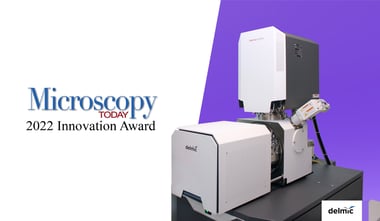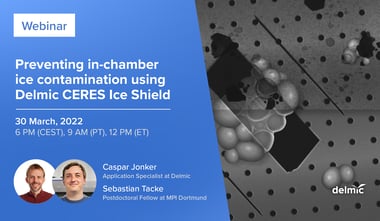The Delmic Cryo-ET Online Symposium 2025 will concentrate on the most recent advancements in cryo-ET techniques, enhancing sample yield and deriving insights from biological systems by applying cryo-ET to cells, multicellular organisms, and tissue specimens.
June 03, 2025 – Delft, Netherlands – Delmic announces its first cryo-ET online symposium on June 30, 2025, bringing cryo-ET experts worldwide to one virtual podium.
Details of speakers and presentations:
Dr Shiwei Zhu, Assistant Professor, Case Western Reserve University, US
SLICK: A Sandwich-LIke Culturing Kit for in situ Cryo-ET Sample Preparation
In situ cryo-electron tomography (cryo-ET) combined with cryo-focused ion beam (cryo FIB) milling has become a powerful approach for visualizing biological structures in their native cellular context. A critical step in this workflow is the culture of mammalian cells on electron microscopy (EM) grids, yet this process remains unoptimized, leading to challenges in reproducibility and throughput. Current methods suffer from grid movement, damage, and uneven cell distribution during cleaning, coating, and medium equilibration.
To address these limitations, we developed the Sandwich-Like Culturing Kit (SLICK), which enhances reproducibility and scalability for both routine and complex cell experiments. SLICK features a mounting area with three stabilizing pillars that secure EM grids while maintaining cell connectivity between the grid and SLICK surface. We validated SLICK using HeLa cells—a standard model in cell biology—and primary neurons, which are highly sensitive to culture conditions. Both cell types exhibited intact grids with uniform cell distribution. Furthermore, its high-throughput capability allows simultaneous culture on over 151 grids per experiment, significantly increasing throughput for in situ structural studies. Our results demonstrate that SLICK significantly improves robustness, scalability, and efficiency in cryo-ET sample preparation, facilitating high-resolution cellular imaging.
Dr Peter Dahlberg, Assistant Professor, Stanford University, US
Registration-free approaches for the guidance of cryogenic focused ion beam milling with accuracy beyond the diffraction limit.
FIB milling is a destructive sample preparation technique for Cryo-ET, in which only the final thin section is preserved for imaging. A critical challenge is determining which specific section to retain in order to capture biological structures of interest. Since the early development of the technique, correlative fluorescence microscopy has been the leading method to guide FIB milling. However, most existing implementations rely on registration-based methods, which estimate target locations by overlaying optical micrographs onto ion images—a process whose accuracy suffers from fundamental limitations. Here, I will discuss the use of ENZEL, a tri-coincident system developed by Delmic, that enables simultaneous light microscopy during FIB milling. This unique capability supports two new guidance strategies that bypass fundamental limitations of registration-based methods, enabling robust targeting of structures with accuracy exceeding the axial diffraction limit by more than an order of magnitude.
 Left: Optical interference measurement during FIB milling. Right: reconstructed virions in a 150 nm vesicle
Left: Optical interference measurement during FIB milling. Right: reconstructed virions in a 150 nm vesicle
Cristina Capitanio, PhD Candidate, Max Planck Institute for Biochemistry and Dr Matthias Poge, Post-doctoral Researcher, now at MPI-CBG, Germany
“FIB-view”: fluorescence imaging from the ion beam perspective guides milling of high-pressure-frozen samples
Cryo-ET can be used on a wide variety of samples, ranging from plunge-frozen cells to high-pressure-frozen (HPF) organisms. These samples need to be first thinned by FIB-milling. Cryo-correlative light and electron microscopy (cryo-CLEM) can guide the thinning process, as well as cryo-ET, to reveal the ultrastructure of fluorescently-labeled target events.
However, current 3D correlative FIB-milling methods face two major challenges: (1) they are heavily affected by poor axial resolution and distortions, and (2) they cannot easily be applied to thick HPF samples. We present a method that offers a simple solution to these challenges. Using a widefield microscope integrated in the FIB-SEM chamber (Delmic’s METEOR), we directly image from the same perspective as the FIB (“FIB-view”). We present a workflow for effective and accurate FIB-view-guided milling of both plunge-frozen yeast and HPF C. elegans. We also demonstrate how FIB-view enables targeted lift-out of plant tissues. The FIB-view method achieves sub-micrometer targeting precision across the full spectrum of cryo-ET samples. This allows cryo-ET to capture elusive and rare events within multicellular samples.

Dr Cathy Spangler, Post-doctoral Researcher, Vollum Institute, US
Cryo-ET investigation of native AMPA receptors at glutamatergic synapses within brain tissue
Chemical synapses facilitate essential communication between neurons by delivering excitatory and inhibitory inputs within neuronal signaling networks. Glutamate is the primary neurotransmitter released at excitatory synapses, where it is detected by ionotropic receptors at the postsynaptic membrane including AMPA receptors (AMPAR). AMPAR are the primary drivers of fast excitatory neurotransmission in the brain and play a major role in synaptic plasticity, forming the molecular basis of learning and memory. Here we develop an approach for sub-nanometer resolution imaging of glutamatergic synapses within near-native cryo-preserved brain tissue using cryo-ET. Using a small gold nanoparticle AMPAR immunolabeling strategy, we have established a pipeline to identify the precise subsynaptic location of individual AMPAR at glutamatergic synapses within hippocampal brain tissue. This approach enables investigation of synapse-specific AMPAR architecture and arrangement within brain tissue at unprecedented resolution and provides an experimental pipeline that can be applied to other synaptic proteins in various brain regions and disease states.

Dr Yi-Wei Chang, Assistant Professor, University of Pennsylvania, US
Enabling cryo-ET imaging of human brain tissue by cryo-plasma FIB sample preparation
Human brain tissue has been traditionally imaged via electron microscopy (EM) after chemical fixation, staining, and mechanical sectioning, which limit attainable resolution and potentially introduce artifacts. Cryo-ET has been used to overcome these limitations to image cellular samples relatively artifact-free and at higher resolution. Challenges that have prevented cryo-ET from being applied to human brain tissue are vitrification and efficient thinning of thick frozen samples. Additionally, most human brain samples are preserved at time of autopsy using chemical fixation or storage at -80°C that produces crystalline ice to damage the fine molecular structural details. In this presentation, I will discuss our method for generating cryo-lamellae sufficiently thin for cryo-ET imaging in human brain tissue obtained at time of autopsy and vitrified without prior fixation or frozen storage. We achieved this by using a modified plunge-freezing workflow to freeze brain tissue up to ~100 μm thick directly on a cryo-EM grid, avoiding complicated HPF protocols that are more commonly used for such thick samples. We followed this by using xenon plasma FIB milling as opposed to the popular gallium FIB milling to generate the lamellae directly on the cryo-EM grid, avoiding cryo-sectioning that introduces artifacts. Cryo-ET successfully revealed a milieu of intact cellular and subcellular structures in brain tissue samples. Furthermore, we visualize myelin in an unfixed, unstained context providing insight into how myelin basic protein tightly holds intracellular polar head groups of the plasma membrane of oligodendrocytes.

Jean Daraspe, Expert Scientist, EM Facility, University of Lausanne, Switzerland
Cryo-FIB/SEM lamellae production as a service on an EM platform
The Electron Microscopy Facility (EMF) is experiencing to provide cryo-lamellae as a service for interinstitutional researcher’s groups. The variety of projects has allowed us to develop a common pipeline taught to researchers, but it is necessary to develop specific steps for each project depending on the type of sample and the scientific question to be explored. Here we show four examples of workflow in cryo-EM:
- We found a way to concentrate in HPF planchet the termite symbiont Trichonympha agilis, on which we perform cryo-CLEM to target the rostrum of this rare organism to precisely do serial lift-out milling followed by cryo-ET to get 3D structure of centrioles.
- We worked on post-mortem human brain samples to target by cryo-CLEM, Multiple System Atrophy (MSA) regions, on which we do serial lift-out milling followed by cryoET to get 3D structure of amyloid type fibril.
- We have developed a workflow for CLEM-cryo-ET on U2OS cells overexpressing centrioles proteins.
- We developed a pipeline to grow human neurons on grids and infect them in a P2 environment with Zika virus before performing Cryo-ET to visualize the infection cycle in situ.
About Delmic
Delmic is passionate about improving the Cryo-ET workflow. Through offering a wide range of solutions designed to integrate effectively with existing cryo-ET workflows, Delmic aims to see nanoimaging ubiquitously accessible. By continually advancing cryo-ET technologies, Delmic supports users in the life sciences field in achieving high-quality cryo lamella yield and obtaining valuable insights for their research and development projects.
Banner image: sample courtesy of Vlada Filimonenko, Electron microscopy core facility, IMG, Prague, Czechia.
.png)









